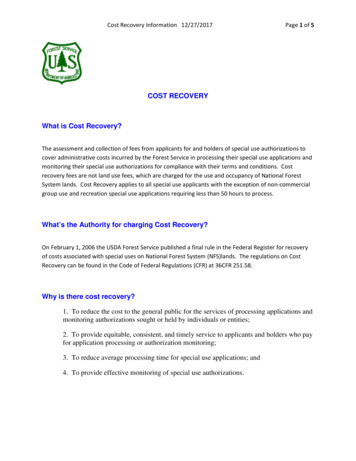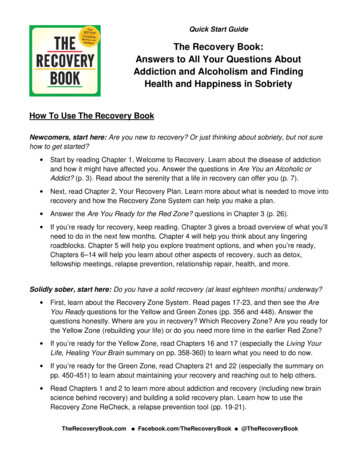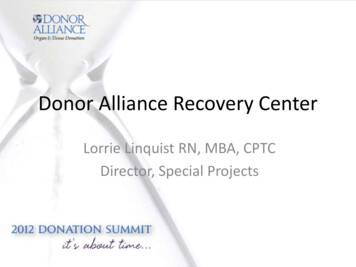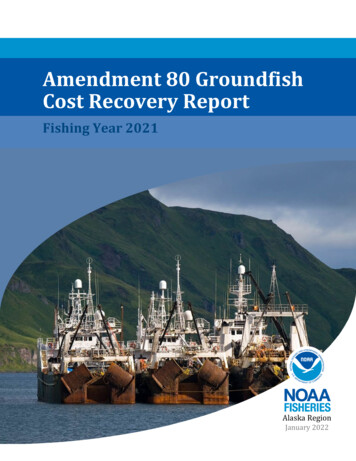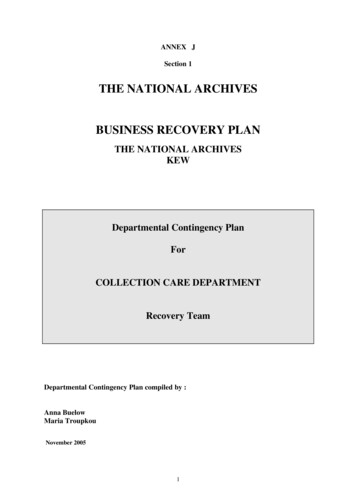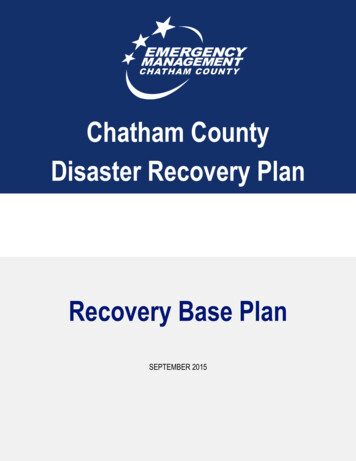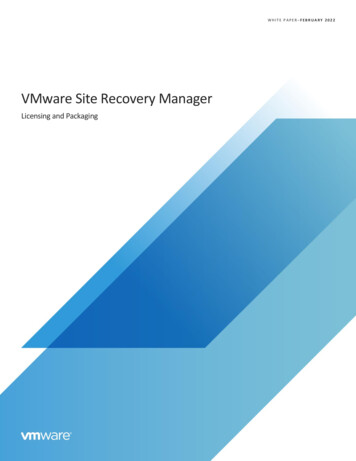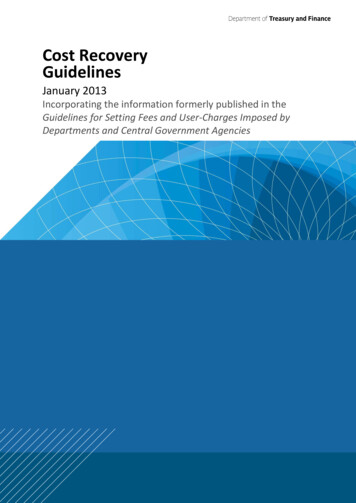
Transcription
Cost RecoveryGuidelinesJanuary 2013Incorporating the information formerly published in theGuidelines for Setting Fees and User-Charges Imposed byDepartments and Central Government Agencies
If you would like to receive this publication in an accessible format, such as large print oraudio, please telephone 9651 0909 or email information@dtf.vic.gov.au. This document isalso available on the internet at www.dtf.vic.gov.au
ContentsConventions . 11.Introduction . 21.1 Purpose and structure of these Guidelines . 21.2 Scope of these Guidelines . 21.3 Application of these Guidelines . 32.Objectives and Principles of Cost Recovery . 52.1 What is cost recovery? . 52.2 Objectives of cost recovery . 52.3 Principles of cost recovery . 73.Output Analysis and Charging Considerations . 103.13.23.33.44.Purpose of output analysis . 10Government provision of goods and services . 10Government regulation to address other market failures . 12Summary . 13Designing and Implementing Cost Recovery Arrangements . 164.1 Checklist of steps . 164.2 Appropriateness of cost recovery. 16Step 1 – Is provision of the output or level of regulation appropriate? . 17Step 2 – What is the nature of the output or regulation? . 18Step 3 – Who could be charged? . 19Step 4 – Is charging feasible, practical and legal? . 19Step 5 – Is full cost recovery appropriate?. 204.3 Cost structures and nature of charges . 22Step 6 – Which costs should be recovered? . 22Step 7 – How should charges be structured? . 27Step 8 – Are the cost recovery charges based on efficient costs? . 294.4 Implementation features . 30Step 9 – What is the importance of consultation? . 30Step 10 – How should cost recovery arrangements be monitored and reviewed? . 305.Process issues . 325.15.25.35.45.55.65.75.8Introduction . 32The annual rate . 32The Monetary Units Act 2004 and automatic indexation policy . 32Preparation of Regulatory Impact Statements for fees. 34Treasurer’s approval . 35Concessions on fees . 36Inter-departmental fees . 36Impact of the Goods and Services Tax . 36i
5.9 Ministerial Standing Directions. 365.10 Reporting requirements . 375.11 Appropriate legal authority . 37Appendices . 38A.Glossary . 39B.Template of Major Cost Items . 41C.Allocation of Indirect Costs . 42Activity based costing (ABC) method . 42The ‘pro rata’ approach. 45D.iiReferences . 46
ConventionsCharges, fees, and leviesIn practice, there are a number of different terms associated with cost recovery. Forexample:‘Regulatory fees’ are characterised by granting access rights to engage in a desiredactivity. For example, access might be in the form of a permit or licence enabling theGovernment to regulate an activity as an instrument of government policy.A ‘user charge’ or ‘fee-for-service’ is the direct charge for the provision of a good orservice by the Government in an open market. Examples include the charge of processinga Freedom of Information request, and the fee for a copy of a marriage, birth or deathcertificate.‘Levies’ are a form of tax that is imposed on a specific industry or class of persons (ratherthan a tax of general application). An example is the building permit levy that is imposedon participants within the housing construction sector.In Chapters 1 to 4 of these Guidelines, ‘charge’ tends to be used as a generic term coveringall cost recovery arrangements.In Chapter 5, to be consistent with the legislation that is discussed, the term ‘fee’ is used tocover all regulatory fees, user charges and fees-for-service that are subject to indexationpolicy and other government processes.Cost Recovery GuidelinesJanuary 20131
1.Introduction1.1Purpose and structure of these GuidelinesThe purpose of these Guidelines is to clarify the Government’s policy principlesunderpinning cost recovery arrangements, and provide a rigorous framework for use bygovernment departments, agencies and regulators when considering, developing and/orreviewing cost recovery arrangements.The Guidelines establish a whole-of-government framework for ensuring that cost recoveryarrangements in Victoria are transparent, efficient, effective and consistent with legislativerequirements and government policy.Government-provided goods and services vary widely in their economic and institutionalcharacteristics. Similarly, the nature of government regulation is diverse. Thus, no singlecost recovery charging mechanism will be appropriate for every case. Consequently, it is notpossible to issue guidance material that is definitive.Rather, these Guidelines are designed to establish a central framework, which provides achecklist and discussion of the key issues on which to base sound analysis and evaluation. Inmany cases, the analysis may not suggest a single charging approach, but will instead help toidentify a range of options for the recovery of costs. The preferred option will then dependon the relative weights given to different criteria, such as efficiency and equity, and onimplementation factors.Thus, it is important that government departments, agencies and regulators develop theirown cost recovery arrangements that customise the central framework to meet their ownparticular circumstances, while ensuring that their arrangements are consistent with theGovernment’s expectations.The Guidelines are structured as follows:The objectives and principles of cost recovery are discussed in Chapter 2. This explainswhat cost recovery is, and considers the rationale of using cost recovery as a means ofachieving efficiency and equity objectives. This chapter also articulates the key policyprinciples that should underpin cost recovery arrangements in Victoria.Chapter 3 looks at output analysis and charging considerations, by examining thedifferent types and characteristics of government-provided goods/services andregulatory activity, and discussing the implications for cost recovery arrangements.A discussion of the different steps involved in the design and implementation of costrecovery arrangements is provided in Chapter 4.Process issues are covered in Chapter 5, which includes information about indexationand appropriate government approval processes, along with other administrativematters, such as concessions and the impact of the Goods and Services Tax.1.2Scope of these GuidelinesThese Guidelines incorporate and expand on the explanatory material that was formerlypublished by the Department of Treasury and Finance in the Guidelines for Setting Fees andUser-Charges Imposed by Departments and General Government Agencies.2Cost Recovery GuidelinesJanuary 2013
The Guidelines apply to cost recovery arrangements of government departments andgeneral government agencies, including the recovery of:the costs associated with the provision of certain government good and services – forexample, those that are subject to user charges or fees-for-service;the costs incurred by government in administering regulation (e.g. registration, licensing,issuing of permits, monitoring compliance, investigations, enforcement activity etc); andthe costs of activities undertaken in natural resource-based sectors (such as forestry,fishing and aquaculture, minerals and petroleum, and land-based industries likeagriculture) and ecological services (including wildlife habitat and food sources, soilconservation, water catchment protection, cleaner air, and recreational services).However, these Guidelines do not apply to:general taxation;local government charges;charges by government business enterprises and private sector-government partnerships(e.g. water authorities and energy suppliers);fines or pecuniary penalties;1rents charged for access to Crown-owned resources;2the setting of taxes, fines or other penalties to limit negative externalities (i.e. harmfuleffects that extend beyond the people directly involved) associated with a particularactivity.It should be noted that these Guidelines describe situations where full cost recovery maynot be appropriate, which includes government services where objectives of incomeredistribution or social insurance are important (e.g. the provision of health, education,public transport and social housing).1.3Application of these GuidelinesThese Guidelines are primarily intended for policy officers within government departmentsand agencies, including those involved in the preparation of Regulatory Impact Statementsthat deal with fees and charges. The Guidelines cover issues to be considered in developingor reviewing cost recovery arrangements. Where some form of cost recovery is deemednecessary, and therefore knowledge of the appropriate cost base is needed, it is expectedthat finance officers will also play a role in the application of these Guidelines.Nevertheless, for any large cost recovery project, the comprehensive application of theseGuidelines will require a broader mix of skills and expertise, including policy, financial,economic, project management and sectoral specific knowledge.1While these Guidelines do not apply to the setting of fines or penalties, Chapter 5 doescontain information relating to the indexation of fines and penalties.2Cost recovery and resource rents are different concepts. Resource rent represents theprofit a natural resource firm makes over and above the normal profit, business costs andgovernment charges that arise because access to the resource is restricted. The profit isover and above the profit that would be required to prompt investment in the resource in acompetitive market.Cost Recovery GuidelinesJanuary 20133
When applying these Guidelines, users should be aware of other policy and regulatoryrequirements and undertake the necessary complementary analysis. Examples include:Victorian Guide to Regulation (available from www.vcec.vic.gov.au).Where formal assessments are required (e.g. through a fees RIS), a sound application of theprinciples in these Guidelines will assist with these assessments.Competitive neutrality guidelines will apply where government-provided servicescompete with services provided by private sector interests. (These are also availablefrom www.vcec.vic.gov.au).Business Impact Assessment and Regulatory Impact Statement (RIS) processes arerequired where consequential changes are required to be made to primary or secondarylegislation, or where new legislation is proposed. These are detailed in the VictorianGuide to Regulation (see www.vcec.vic.gov.au).Where essential services are affected, regulatory oversight of the Essential ServicesCommission may apply (see www.esc.vic.gov.au).In addition, the Standing Directions of the Minister for Finance under the FinancialManagement Act 1994 (available from government DMA/DMA July-06-Update.doc) specify anumber of relevant matters that must be complied with in respect to implementing andmaintaining appropriate financial management practices, including in relation to charges forgoods and services. These matters are outlined in Chapter 5 of these Guidelines.4Cost Recovery GuidelinesJanuary 2013
2.Objectives and Principles of Cost RecoveryThis chapter examines the role of cost recovery, and considers the rationale for costrecovery as a means of achieving efficiency and equity objectives. There is also discussionabout the principles that should underpin cost recovery arrangements in Victoria.2.1What is cost recovery?In the past, it was common for many government activities to be largely funded fromgeneral taxation revenue. More recently, however, with a desire to improve efficiency andequity outcomes, governments have increasingly been recovering some or all of the costs ofvarious activities by more direct means.In the case of general taxation, revenue is raised to fund a wide range of governmentactivities, and there is rarely a direct link between the source of the tax and the expenditureof the revenue raised from that tax. In contrast, cost recovery is the recovery bygovernment of some of all of the costs of a particular activity.Cost recovery may be defined as the recuperation of the costs of government-provided orfunded products, services or activities that, at least in part, provide private benefits toindividuals, entities or groups, or reflect the costs their actions impose.In practice, cost recovery involves setting and collecting charges to cover the costs incurredin undertaking activities such as:the provision by government of certain goods and services purchased by customers(e.g. Freedom of Information requests, title searches);the administration of regulation (e.g. registration, licensing, issuing of permits,monitoring compliance, investigations, enforcement activity etc); andgovernment measures in natural resource-based sectors (such as forestry, fishing andaquaculture, minerals and petroleum, and land-based industries like agriculture) andecological services (including wildlife habitat and food sources, soil conservation, watercatchment protection, cleaner air, and recreational services).The costs of these activities will need to be recovered in some way – either from users orothers who benefit from the good, service or activity; those whose actions give rise to it; orfrom taxpayers more generally.2.2Objectives of cost recoveryWhen designed and implemented appropriately, the adoption of cost recovery has thepotential to advance efficiency and equity objectives.3 Achieving these goals is important,3Cost recovery can also advance fiscal sustainability goals. Cost recovery can provide atransparent way for government agencies and for government agencies and regulators toidentify and fund the cost of undertaking their activities without the need to rely solely onrevenue secured through the budget process. This potential for reduced reliance on generaltaxation revenue can relieve fiscal pressures, and ensures that general taxation revenue isdiverted to more appropriate sources.Cost Recovery GuidelinesJanuary 20135
not only from a government perspective, but also because of the benefits provided tobusinesses and the community as a whole.Efficiency and equity considerations may need to be balanced against each other indetermining the appropriate form of cost recovery.Efficiency objectivesAppropriate cost recovery can improve the way that resources are allocated within theeconomy, thereby contributing to allocative efficiency (a situation where resources areallocated in a way that maximises the net benefit to society). Allocative efficiency isachieved when the value consumers place on a good or service equals the cost of resourcesused up in production. By requiring payment for goods/services provided by government,cost recovery charges can give important signals to users about the costs of the resourcesinvolved in their provision. Full cost recovery ensures that all the relevant costs of bringingthe good/service to market are incorporated in the relevant price signals.The recovery of costs incurred by government in undertaking regulatory activity will havesimilar allocative efficiency effects. Incorporating the costs of administrating governmentregulation into the prices of regulated products and services ensures that the costs to thecommunity of the resources used to allow the regulated activity to take place will becomeapparent to producers and consumers. This means that activities that require high levels ofregulation are not favoured over activities that require low levels of regulation.By decreasing the level of general taxation needed to finance government products, servicesor regulated activities, cost recovery also reduces the costs of tax administration andcompliance, and the ‘deadweight loss’ of tax-related distortions.4Equity objectivesWhen used in a public finance context, equity can have both horizontal and verticaldimensions.Horizontal equity refers to treating people in similar situations in similar ways. In the case ofcost recovery, horizontal equity refers to those who benefit from government activities, orthose that contribute to the need for government regulation, having to pay the associatedcosts. This improves equity because it avoids the situation where all taxpayers have to paythe associate costs regardless of whether or not they benefit from – or give rise to the needfor – the government activity/regulation.Moreover, the establishment of a standard cost recovery framework improves equity byfacilitating consistent treatment across regulated industries. Meanwhile, cost recoveryarrangements that incorporate competitive neutrality principles also ensure that there isconsistent treatment between private and public sector entities by making appropriateadjustments to offset any cost advantages or disadvantages arising from governmentownership.Vertical equity, on the other hand, refers to those with greater means contributingproportionately more than those with lesser means. In the context of cost recovery, verticalequity may be affected if different charging arrangements apply to different groups of users4In economics, a deadweight loss is a loss in economic efficiency that can arise from theimposition of taxes (amongst other things) because the tax prevents some people fromengaging in what they perceive as mutually-beneficial transactions.6Cost Recovery GuidelinesJanuary 2013
or industries. For example, concessions may be provided on certain charges to particularuser groups (e.g. those on low incomes), where the goal is to maximise these groups’ accessto certain goods and services.2.3Principles of cost recoveryFull cost recoveryAs stated in the Victorian Guide to Regulation,5, general government policy is that regulatoryfees and user charges should be set on a full cost recovery basis because it ensures thatboth efficiency and equity objectives are met. Full cost represents the value of all theresources used or consumed in the provision of an output or activity. (The calculation ofrecoverable costs is discussed in Step 6 in Chapter 4).Full cost recovery is consistent with achieving the efficiency and equity objectives outlinedin Section 2.2 above:Full cost recovery promotes the efficient allocation of resources by sending theappropriate price signals about the value of all the resources being used in the provisionof government goods, services and/or regulatory activity.From a horizontal equity point of view, full cost recovery ensures that those that havebenefited from government-provided goods and services, or those that give rise to theneed for government regulation, pay the associated cost. Those parties that do notbenefit or take part in a regulated activity do not have to bear the costs.While general policy is for costs to be recovered on a full cost basis, there are neverthelesssituations where it may be desirable to recover at less than full cost, or not to recover costsat all. Examples of such situations are discussed in more detail in Chapter 4, and includecircumstances where:practical implementation issues make cost recovery infeasible;there are benefits to unrelated third parties (sometimes referred to as ‘positiveexternalities’);social policy or vertical equity considerations are considered to outweigh the efficiencyobjectives associated with full cost recovery; and/orfull cost-recovery might adversely affect the achievement of other government policyobjectives.Where the government is providing goods and services on a commercial basis, incompetition with the private sector, it is appropriate for charge to be set at the commercialmarket price – even if this implies a level that exceeds full cost recovery.Even in cases where there may be justifiable reasons to depart from the full cost recoveryprinciple, these Guidelines still provide the central framework of the various issues thatneed to be addressed when designing cost recovery arrangements.For more information, refer to:Is charging feasible, practical and legal – Step 4 in Chapter 4.Is full cost recovery appropriate? – Step 5 in Chapter 4.Which costs should be recovered? – Step 6 in Chapter 4.5See Section 3.2.13 of the Victorian Guide to Regulation.Cost Recovery GuidelinesJanuary 20137
Other principles of well-designed cost recovery arrangementsThere are other principles that need to be taken into account when designing andimplementing cost recovery arrangements. These may be grouped into principles relating tothe appropriateness of cost recovery; those that affect the nature of cost recovery charges;and other desirable implementation features of cost recovery arrangements.These principles are outlined below, and are incorporated into the discussion of thedifferent steps involved in practical design and implementation of cost recoveryarrangements in Victoria, which is the focus of Chapter 4.Appropriateness of cost recoveryCost recovery arrangements should be:consistent with, and supportive of, the policy objectives of cost recovery: cost recoveryarrangements should advance the cost recovery objectives of efficiency, equity and fiscalsustainability.imposed directly, where possible: recovering costs directly from those that benefit from,or whose actions give rise to the need for, the government good/service/activity is mostlikely to advance the objectives of cost recovery. Nevertheless, there may be situationswhere practical implementation considerations dictate where the charge is imposed(e.g. it may be more cost effective to charge representative agencies);cost effective and practical: the cost of administering cost recovery arrangements shouldbe less than the value of the costs recovered. Potential levels of evasion should not beunacceptably high;feasible and legal: there are no insurmountable policy, legal or other impediments to theimplementation of cost recovery arrangements; andconsistent with other policy objectives: cost recovery arrangements should at least becompatible with, if not complementary to, the overarching outcomes the Governmentseeks to advance through providing or funding products and services. Furthermore, costrecovery arrangements should not jeopardise other government objectives – forexample, by restricting or stifling competition and industry innovation.For more information, refer to:Chapter 3 – Output Analysis and Charging Considerations.Section 4.2 of Chapter 4 – Steps 1 to 5.Nature of cost recovery chargesCost recovery charges should:be set according to an ‘efficient’ cost base: best practice cost recovery arrangementsrequire that charges are set at a level that recover the ‘efficient’ (i.e. minimum) costs ofproviding the good/service at the required quality, or of undertaking the necessaryregulatory activity;not be used to finance/achieve unrelated activities/objectives: cross subsidies shouldbe avoided because they are inequitable and often create incentive effects that arecontrary to the desired efficiency objectives;avoid volatility: a framework of cost recovery charges that smooth year-on-yearfluctuations will facilitate the forward planning processes of government, enterprises andindustries; andbe simple to understand: complex arrangements that are theoretically pure mayintroduce unjustified costs and unnecessary confusion.8Cost Recovery GuidelinesJanuary 2013
For more information, refer to:Sections 4.3 of Chapter 4 – Steps 6 to 8.Implementation featuresWhen implementing cost recovery arrangements, it is important that they be:decided in consultation with relevant parties: cost recovery arrangements will benefitfrom the information and insights of relevant parties, and are more likely to succeed ifthose parties have some degree of ownership of the arrangements;transparent, with clear accountability: this will help to build trust in the integrity of theprocess, and will impose a discipline to keep costs down to ‘efficient’ levels; andmonitored and reviewed regularly: this will ensure that they continue to be appropriateand based on relevant costs.For more information, refer to:Section 4.4 of Chapter 4 – Steps 9 and 10.Cost Recovery GuidelinesJanuary 20139
3.Output Analysis and Charging ConsiderationsThis chapter examines the different types and characteristics of government-providedgoods/services and regulatory activity, and discusses the implications for cost recoveryarrangements.3.1Purpose of output analysisDeciding the appropriate nature of charging regimes requires a detailed analysis of theoutputs and outcomes that arise from government activities. As such, it is important thatthese outputs and outcomes are described and analysed in sufficient detail in order to beable to determine:the economic characteristics of the outputs/outcomes arising from the activity – forexample, where they sit on the public private good ‘continuum’;the beneficiaries of the government activity (including any unintended third-partybeneficiaries);the parties and circumstances that create the need for the government activity; andwhether the activity contributes to achieving other policy objectives or desired outcomesbeyond those that it is intended to achieve.This analysis will help to decide whether full cost recovery is appropriate, or whether partialcost recovery or funding from general taxation should be considered. It will also identifyfeasible options of which entities should be charged.This chapter categorises government activities under two broad headings:the provision of goods and services (Section 3.2); andregulation to address other market failures (Section 3.3).3.2Government provision of goods and servicesThis section discusses the different economic characteristics of the goods and servicestypically provided by government, which need to be taken into account when consideringappropriate charging mechanisms.Typically, the ‘beneficiary pays’ approach can be used to identify who should pay for theprovision of government goods and services. Under this approach, private parties should, ingeneral, me
The objectives and principles of cost recovery are discussed in Chapter 2. This explains what cost recovery is, and considers the rationale of using cost recovery as a means of achieving efficiency and equity objectives. This chapter also articulates the key policy principles that should underpin cost recovery arrangements in Victoria.
